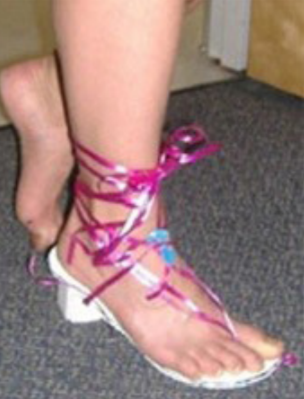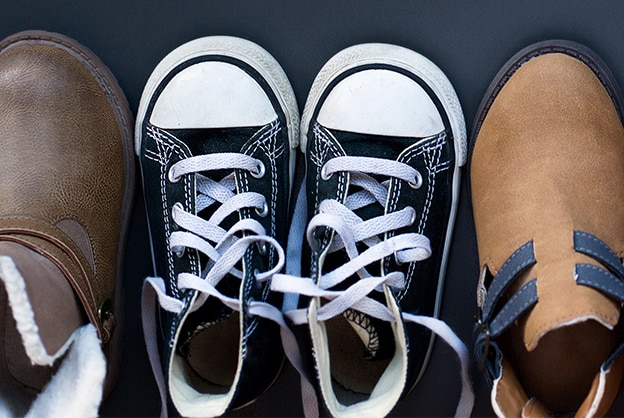Overview
STEM careers
Time
Materials
Per Group:
|
Per Team:
|
Relevant Terminology
Prototype: An initial model of something from which other variations or innovations are developed.
Introduce
GETTING READY
Set up an obstacle course for testing the shoes. This can be a tape line that must be walked—around chairs, up and down off a stool, over objects, or anything else that will work in your space. If you are building shoes in a public space, you might want to rope off the obstacle course.
Depending on your space and the audience you are working with, you can place the hot glue guns on a central table to be shared or distribute one to each team.
INTRODUCTION
Engineers are creative problem solvers. That same creativity is used whether an engineer is designing a bridge or a shoe. Today you will design a shoe prototype that is stylish and can be worn around an obstacle course.
Invite participants to suggest what an engineer needs to consider when designing a shoe. How would an engineer approach this problem? As needed, bring up the following:
- Who is wearing the shoe?
- What are the qualities of a good shoe? (Comfortable, durable, and flexible, not to mention stylish.)
- What different functions might a shoe be designed for?
- What criteria do engineers need to know when designing a shoe? (Intended use, costs, availability of materials/resources, manufacturability.)
- What subjects do engineers have to know about in order to design a shoe? (Physics, materials science, human anatomy.)
- How can engineers test a shoe design? (Test materials and construction with machines, human input.)
Engineers often work on teams that have members with different types of expertise and perspectives to help brainstorm creative solutions. They also go through several iterations of designing, building, and testing a prototype to constantly improve the product.
Instructions

A heeled shoe made of foam-core board and ribbon. Credit: Lauren Cooper, ITL Program, College of Engineering, University of Colorado Boulder.
Introduce the design challenge: teams of 2–3 participants will design and build a pair of stylish shoes to be worn around an obstacle course. Provide the following constraints:
- The shoes must have at least a 2″ heel.
- The shoes must stay on the foot on their own.
- The shoes must be a matching pair.
- The shoes must be stylish.
Give the participants time to plan their shoes. They should think about how to build the heel, how to fasten the shoe to the foot, and how to make the shoe durable. Encourage teams to sketch their designs on paper before they build.
Once they have a plan, teams should build the shoes to fit one team member.
- Exercise caution when using hot glue guns and knives, and supervise children in their use. Offer to help any participants who do not feel comfortable using the tools, but take the opportunity to teach them proper use. You may need to cut or glue materials for some teams.
When the shoes are complete, ask each team to submit their shoes to you for evaluation. Check for any obvious design flaws (loose heel, not fastened to foot, doesn’t conform to foot, etc.) and check that the shoe meets the 2″ heel requirement. One member of the team may then wear the shoes to complete the obstacle course.
- Observe how the shoes perform and identify weak points. Give teams time to make improvements and test the shoes again.
- Vote on which shoe is the most stylish.
ACTIVITY VARIATIONS
Ask participants to consider other articles of clothing that might be engineered to have special properties. Provide examples of waterproof/ breathable fabrics, stain-resistant or odor-resistant fabrics, nano coatings, and so on.
Incorporate a catwalk to showcase all the shoe designs while everyone cheers on the models/walkers.
Guiding questions
GUIDANCE FOR PARTICIPANTS
QUESTIONS TO ASK AFTER THE ACTIVITY
- How did you test your design before going through the obstacle course? How many times do you think engineers test or retest their designs?
- Who did you design your shoe for? How did that affect your design?
- How did you use the materials to address stress points, attaching different parts, and supporting enough weight? Explain your thinking.
- What other supplies could you have used to build your shoes? How would you have used these additional materials?
Engineering & science connections
GUIDANCE FOR PARTICIPANTS
Engineering Connections
Having the right shoe for the right job is incredibly important. Imagine running a marathon in clogs or climbing a mountain in high heels! Designing the perfect shoe is a collaboration among biomedical engineers, materials engineers, mechanical engineers, and shoe designers. For example, sneakers are well- engineered products that combine visual appeal and functionality. The biomedical engineer and mechanical engineer help to make highly functional shoes so that the shoes fit well and help people perform their desired tasks while wearing them, while the materials engineer helps to select the appropriate materials. Engineers must ask themselves numerous questions when they work on a shoe. Ultimately, these engineers must consider a lot of characteristics, such as traction and cushioning, in order to make a shoe that will appeal to consumers and serve their needs.
Science Connections
Making the perfect shoe is no easy feat! Engineers use physics and experimental data in order to examine shoes and how their design affects the way people feel while and after wearing them. High heels may be a popular shoe design, but anyone who has worn high heels for any period of time knows that they lead to sore feet and can even lead to more serious health problems if worn a lot. Scientists help engineers by collecting data to study how a person stands and how the angle and height of a shoe can alter a person’s stance by shifting the center of gravity. Although this may not seem important, even the slightest shift of a person’s weight or stance caused by a shoe can dramatically affect the comfort of the wearer as well as the wear and tear on that person’s joints and body.
The source of this material is the TeachEngineering digital library collection at www.TeachEngineering.org. All rights reserved.
www.teachengineering.org/sprinkles/view/cub_fancyfeet
Supplemental content adapted for Dream Big Activities by the Carnegie Science Center.


0 Comments